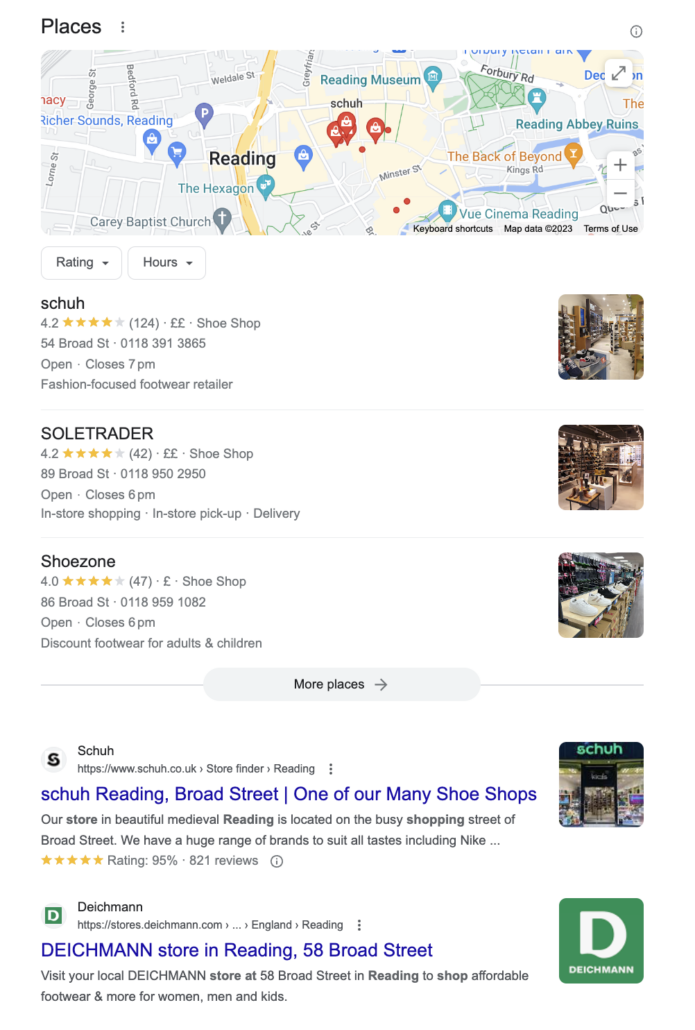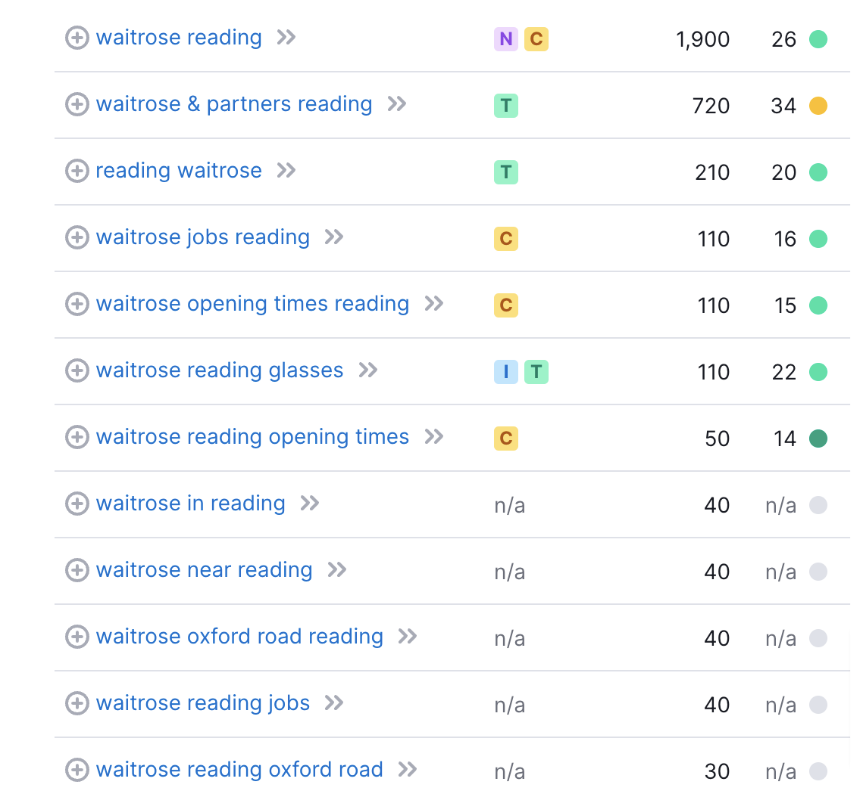If you’re looking for ways to drive highly targeted, high-converting traffic to your ecommerce site, Local SEO is definitely something you should consider.
Local SEO offers significant opportunities for ecommerce businesses because it can help build visibility in a particular geographic region as people search online for items they need or want.
This post will offer insights and advice into why local SEO is so important, provide actionable strategies that will ensure success with a local SEO strategy, and give tips that will help drive maximum impact from every effort you put into targeting customers in specific locations.
What is local SEO?
Local SEO is the practice of optimising a website for higher visibility in localised search results.
To put this into context, when searching for a local business such as a shoe shop, you might enter queries like ‘shoe shop near me’ or ‘shoe shop in Reading’ into Google.

Google considers the user’s location and any reference to a particular area to provide the most relevant result for the query. It would, of course, be unhelpful for Google to serve results for shoe shops in Cheshire when a user is searching in Reading.
The above screenshot shows these results are highly localised towards the Reading area, since Google personalises results based on users’ location and IP address.
Why is local SEO important for ecommerce businesses?
Local SEO is highly advantageous for ecommerce businesses for a number of reasons. Firstly, a large number of searches that take place in Google have local intent. This means that users are searching for a product or service within close proximity.
In accordance with recent data from Think With Google, 76% of people who search on their smartphones for something nearby visit a business within a day and 28% of searches for something nearby result in a purchase.
These statistics only reiterate that local SEO is highly beneficial to driving awareness, and purchases for ecommerce businesses.
So how does Local SEO work?
The local SEO algorithm explained
When it comes to optimising your website for local search, the basics are all the same as with traditional SEO. Any website that wants to perform well in search results should be indexable, load and interact quickly, have the correct metadata, include relevant keywords and so on.
But there are a few extra things to consider when it comes to Local SEO.
Google explicitly states that it looks at the following things as part of its local algorithm:
- Relevance: This is how well a local business matches what the user is searching for.
- Distance: How far each potential search result is from the location term used in a search.
- Prominence: Prominence refers to how well-known a business is.
So how can e-commerce businesses improve their online presence in accordance with Google’s algorithm?
Let’s look at some best practices around local SEO, using some real world examples.
Setting up a Google business profile
One way to increase visibility in local searches is to set up a Google Business Profile. A Google Business Profile allows ecommerce sites to manage how they appear in the local listings
By appearing in the local pack with a Google Business Profile, businesses can easily attract more customers given the visibility of this particular SERP feature.

When it comes to optimising a Google Business Profile we suggest looking at the following.
- Select the right category to ensure your business is displayed to the right audience.
- Use imagery that accurately represents the business (e.g., people working, staff members, interior and exterior shot and photos of products).
- Describe your business accurately to build trust and help customers make informed choices.
- Ensure that images are appropriately tagged with relevant keywords and descriptions.
- Include relevant questions and answers in the Q&A section to address common queries from customers.
- Double-check and update the opening times to ensure accuracy.
- Implement UTM tags for tracking purposes, following the guidance in Claire Carlisle’s UTM tagging guide for Google Business Profiles, particularly in light of the mandatory GA4 implementation.
- Encourage customers to leave positive reviews on your Google Business Profile.
- Respond promptly and professionally to customer reviews, both positive and negative, to show your engagement and dedication to customer satisfaction.
- Monitor and address any negative reviews or feedback to resolve customer issues and improve your business’s reputation.
- Provide excellent customer service to increase the likelihood of receiving positive reviews and recommendations from satisfied customers.
- Share posts frequently via the platform as a way to keep your audience engaged and boost visibility.
It’s also worth noting that large nationwide stores may have multiple Google Business Profiles, with one for each different store. Careful consideration will need to be taken to ensure that traffic from Google Business Profiles is attributed to the correct store. Again, I highly recommend Claire Carlisle’s Guide on this.
Localised store pages
For ecommerce businesses with multiple stores across multiple areas, it’s good practice to create localised storefront pages directly on the website as a means of attracting relevant traffic.
For example, when looking at keyword volumes for the brand Waitrose, it is clear to see that high numbers of people were searching for information around the specific Reading store.

In addition to capturing traffic from local searches, specific store pages can be highly useful in providing users with additional information that pertains to the store nearest to them. For example, certain stores may offer a unique service that is not available in other stores. What is more, certain stores may have different opening hours.
When it comes to creating localised store pages on your website, it would be beneficial to include some of the following:
- Localised metadata with a particular focus on Title Tags, H1’s and Meta Descriptions.
- A brief overview of the store and its location. Where possible make reference to local amenities to provide context to Google such as nearby transport links.
- Accessibility options.
- The store’s opening hours.
- An embeddable Google Map.
- Relevant testimonials specifically from shoppers within that store.
- Specific services and facilities that are available in that store.
- Links to other relevant stores nearby.
Some good examples of localised store pages can be seen across various large retailers:


Local citations and NAP
In local SEO, citations are where your business’s name, address, and phone number (referred to by the acronym NAP) are mentioned on other websites such as directories. These websites can often provide backlink opportunities to a local landing page.
It’s highly important that an ecommerce website’s Name, Address and Phone Number are consistent across the web. Consistency holds great importance for Google when it comes to your listings. When each listing is consistent across sites, Google can be confident the information is accurate, so will showcase your contact details to users when relevant queries arise.
Keeping a check on citations to ensure the correct details are present can be a highly tricky task, which is why we do advocate the use of tooling. There are numerous tools available such as Brightlocal and Whitspark.
For the purpose of this example, let’s use Semrush.
Semrush has a great feature known as ‘Listings Management’ which outlines where a business is cited online and whether the details are correct. It even has the ability to suggest new places to obtain citations as well as allow for bulk listing edits.

Local structured data
Structured data can play an important part in further signifying to Google that a business operates within a local area. This can be achieved by using Local Business Structured Data.
With Local Business Structured Data, you can tell Google various pieces of information about your business, such as:
- Opening times
- Customer reviews
- Different departments
By marking up these data points, businesses can obtain a local business listing thus gaining more prominence in the search results.
Final thoughts
The value of incorporating local SEO elements into a successful ecommerce SEO strategy cannot be overstated. From leveraging Google Business Profiles and crafting local shop pages to keeping uniform business details across platforms, these strategies combine to boost online visibility and customer interaction both offline and online.
For more support with achieving your local SEO goals, get in contact with the expert team at Re:signal today.



